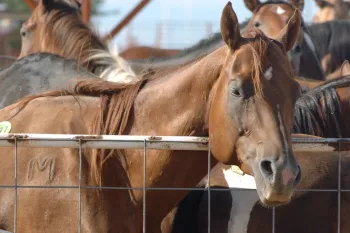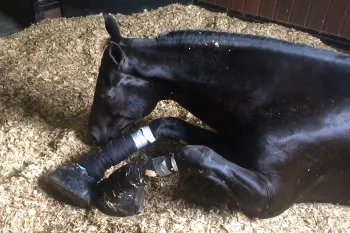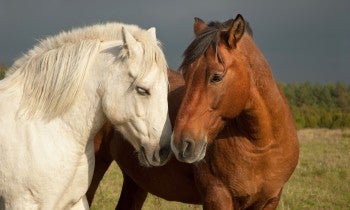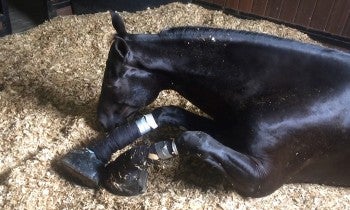Search
Found 93 results for horse transport
Horse Transport and Slaughter
The European horsemeat industry centres around Italy and Spain, where nearly half of all European horses slaughtered for meat are killed [PDF]. Each year, many tens of thousands of equines are transported to Italy from elsewhere in Europe to be butchered. Almost half of those animals are killed in
Legislation making it safer for wildlife to cross highways and mandating reforms for horse transport moves to full House for vote
A key House committee has approved a package of investments in America’s infrastructure, including provisions to make U.S. roadways safer for both drivers and wildlife and to create more humane conditions for transporting horses within the country. The INVEST in America Act package, H.R. 2, passed
Breaking news: U.S. House passes major infrastructure package with key provisions for wildlife corridors, horse transport
The U.S. House has just approved provisions that would make highways safer for wildlife to cross and create safer conditions to transport horses across the country, as part of the Moving Forward Act, a package of reforms designed to restore America’s aging infrastructure. The measures approved today
Resources for making a humane end of life decision for your horse
This list is provided as a resource for horse owners and is for informational purposes only. Please contact specific vendors for more information on their services. Every effort has been made to
What is horse soring?
Soring involves the intentional infliction of pain to a horse's legs or hooves in order to force the horse to perform an artificial, exaggerated gait. Caustic chemicals—blistering agents like mustard
Horse slaughter
Equine disaster preparedness
Contents Plan for your equines Evacuating without your equines Equines and floodwater Equines and barn fires
Breaking: US House passes amendments to transportation bill containing big wins for animals
Update 7/1/2021: The INVEST in America Act (H.R. 3684) has passed the U.S. House of Representatives by a vote of 221 to 201. We urge the U.S. Senate to include the House amendments in their version of the bill and pass it swiftly in order to make these historic wins for animals law. Horses and
Breaking: In a huge win for horses, USDA announces final rule seeking to end horse soring
The U.S. Department of Agriculture has announced a final rule to stop a strange, persistent and deeply disturbing cruelty that has survived more than a half century’s legislative attempts to suppress it. In a huge win, the new rule bans the use on Tennessee walking and racking horses of devices and
The time to stop horse slaughter is now. Here’s why.
Last Saturday, Americans tuned in to watch the Preakness Stakes, the second leg of thoroughbred horse racing’s Triple Crown. On the same day, the New York Times exposed horrific details of our country’s wild horses ending up at slaughter plants in other nations; Americans who had obtained these
Breaking news: U.S. reinstates safeguards to prevent wild horse and burro slaughter
By Kitty Block and Sara Amundson In a major victory for our campaign to protect wild horses and burros, the United States this week reinstated important safeguards that will prevent unscrupulous kill buyers from purchasing large numbers of these iconic American animals and funneling them to
There is simply no way to make horse slaughter humane
Update 6/16/23: The Save America’s Forgotten Equines (SAFE) Act has been introduced in the U.S. Senate (S. 2037) by Sens. Bob Menendez, D-N.J., and Lindsey Graham, R-S.C. The U.S. still exports tens of thousands of horses to slaughter. It’s well past time we permanently ban domestic horse slaughter
Second Texas animal rescue response in two weeks saves 150 horses
With many of our Animal Rescue Team members still in Killeen, Texas caring for the nearly 200 cats we rescued there less than two weeks ago in an alleged neglect case, other HSUS responders went to another property in Texas on Thursday rescuing approximately 150 equines—including horses, mini-horses
U.S. House members hear compelling testimony on bills to protect horses from drugging, slaughter
Members of the U.S. House signaled their interest in protecting American horses by holding hearings on two important bills this week: one to stop the dangerous practice of drugging racehorses to enhance their performance on the tracks or disguise pain, and another to keep American equines from
HSUS, other advocacy groups sue to stop sale of California wild horses to slaughter
The Humane Society of the United States, joined by several other organizations, is suing to stop the U.S. Forest Service from carrying out a plan that could result in the sale of wild horses, now being rounded up in California, to slaughter. Earlier this month, I told you about the misguided plan to
U.S. Forest Service removing 1,000 wild horses in California; some could be sold for slaughter
A federal agency yesterday started removing nearly 1,000 wild horses from the Devil’s Garden territory in California’s Modoc National Forest. Animals more than 10 years old who are not adopted could be sold to “kill buyers” for a dollar and then end up in a slaughterhouse in Canada or Mexico. All of
Horse Slaughter in Canada
With nearly 72,000 horses slaughtered in 2013 alone, Canada’s horse slaughter industry is among the largest in the world, and a shameful betrayal against our loyal companions. Horses are slaughtered in Canada primarily to provide horse meat to European and Asian countries. Horses are brought to
Horse Slaughter: Importing Cruelty
What many European horsemeat consumers do not know is that, in addition to the 250,000 horses that are annually slaughtered for food in the European Union, huge quantities of horsemeat are also routinely imported to the EU from the other side of the globe. Argentina, Mexico, Canada, Uruguay and
Horse Slaughter and the Horsemeat Trade in Europe
The European Union lies at the very heart of the global horsemeat trade. Each year 250,000 horses are killed for their meat in Europe, with many tens of thousands of those horses suffering long-distance transportation to industrialised slaughter plants to feed European consumers. In order to satisfy















